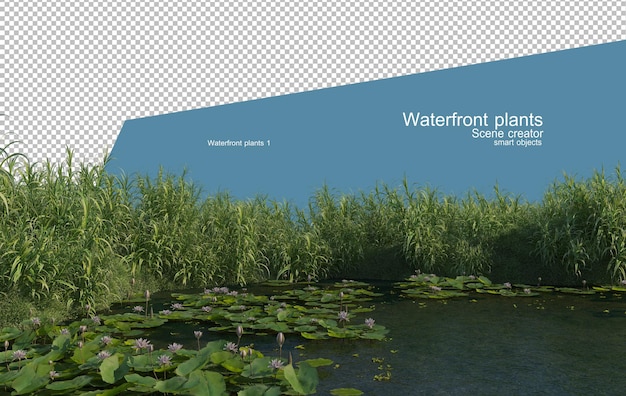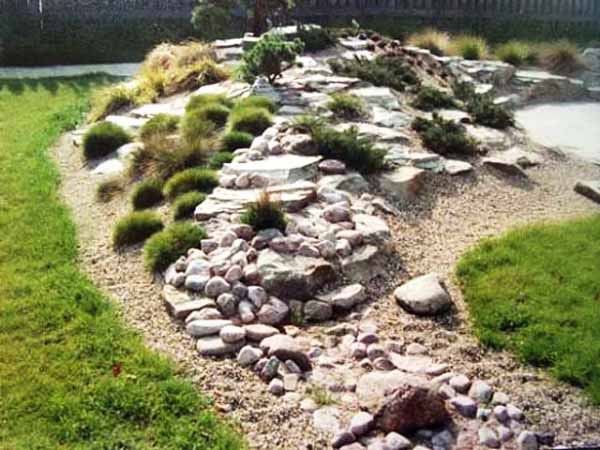
Designing Dreams: Selecting the Perfect Plants to Frame Your Waterfront Views
Imagine waking up every morning to the gentle sounds of water, the fresh scent of nature, and a breathtaking view framed by lush greenery. For those fortunate enough to live near a waterfront, whether it’s an ocean, lake, river, or even a pond, the landscape becomes an integral part of daily life. Choosing the right plants can transform a simple waterfront property into a stunning oasis, enhancing its beauty, providing privacy, and creating a serene environment. However, selecting plants for waterfront locations requires careful consideration of various factors, from soil conditions and climate to the specific characteristics of the water body and local regulations.
Understanding Your Waterfront Environment
Before diving into the exciting world of plant selection, it’s crucial to understand the unique characteristics of your waterfront environment. This knowledge will serve as the foundation for making informed decisions that ensure the long-term health and beauty of your landscape.
Assessing Soil Conditions
Soil is the foundation of any successful garden, and waterfront properties often present unique challenges. The soil near water bodies can be sandy, saline, poorly drained, or even a combination of these. Sandy soils drain quickly and may lack essential nutrients, while saline soils can inhibit the growth of many plants. Poorly drained soils can lead to root rot, a common problem in waterfront environments. To determine the specific characteristics of your soil, conduct a soil test. This simple test will reveal the soil’s pH level, nutrient content, and drainage properties. You can purchase a soil test kit at most garden centers or send a sample to a professional soil testing laboratory. Once you have the results of your soil test, you can amend the soil as needed to create a more favorable growing environment. For sandy soils, consider adding organic matter such as compost or peat moss to improve water retention and nutrient content. For saline soils, choose salt-tolerant plants and consider installing a drainage system to remove excess salt. For poorly drained soils, improve drainage by adding organic matter or installing a French drain.
Evaluating Climate and Weather Patterns
The climate and weather patterns in your area will also play a significant role in determining which plants will thrive in your waterfront landscape. Consider factors such as temperature extremes, rainfall patterns, wind exposure, and the length of the growing season. Plants that are well-suited to your local climate will be more likely to survive and flourish with minimal maintenance. For example, if you live in a coastal area with strong winds, choose plants that are wind-resistant. If you live in an area with hot summers and mild winters, select plants that can tolerate heat and drought. Consult with local nurseries or gardening experts to learn about the best plants for your specific climate.
Considering Water Body Characteristics
The specific characteristics of the water body adjacent to your property will also influence your plant selection. Consider factors such as the water’s salinity, water level fluctuations, and the presence of aquatic wildlife. Saltwater environments require salt-tolerant plants, while freshwater environments offer a wider range of options. Water level fluctuations can impact the types of plants that can be grown near the water’s edge. Plants that are tolerant of periodic flooding are ideal for areas that experience significant water level changes. Be mindful of the presence of aquatic wildlife, such as ducks, geese, and muskrats, which may feed on certain plants. Choose plants that are less palatable to these animals to minimize damage.
Understanding Local Regulations and Restrictions
Before making any significant changes to your waterfront landscape, it’s essential to understand local regulations and restrictions. Many waterfront communities have specific rules regarding vegetation management, shoreline protection, and the use of fertilizers and pesticides. These regulations are designed to protect water quality, prevent erosion, and preserve the natural beauty of the waterfront environment. Contact your local government or homeowner’s association to learn about any applicable regulations before planting anything. Failure to comply with these regulations can result in fines or other penalties.
Choosing the Right Plants for Your Waterfront Landscape
Once you have a thorough understanding of your waterfront environment and local regulations, you can begin the exciting process of selecting plants. Consider the following factors when making your choices:
Salt Tolerance
If you live near saltwater, salt tolerance is a critical consideration. Salt spray and saline soils can damage or kill many plants, so it’s essential to choose species that can withstand these conditions. Some excellent salt-tolerant plants include sea oats, beach grasses, bayberry, and saltbush. These plants are adapted to thrive in salty environments and can help stabilize the shoreline and prevent erosion.
Erosion Control
Erosion is a common problem in waterfront areas, as waves and currents can gradually wear away the shoreline. Planting vegetation with strong root systems can help stabilize the soil and prevent erosion. Native grasses, such as switchgrass and cordgrass, are excellent choices for erosion control. These grasses have deep roots that bind the soil together and prevent it from being washed away. Shrubs and trees can also help prevent erosion by intercepting rainfall and reducing runoff.
Privacy and Screening
Waterfront properties often offer stunning views, but they can also lack privacy. Planting trees and shrubs can create a natural screen that blocks unwanted views and provides privacy for you and your family. Consider planting evergreens, such as junipers and pines, to provide year-round privacy. Deciduous trees, such as maples and oaks, can provide shade in the summer and allow sunlight to filter through in the winter.
Aesthetics and Beauty
Of course, aesthetics are also an important consideration when choosing plants for your waterfront landscape. Select plants that complement the natural beauty of the waterfront environment and create a visually appealing landscape. Consider factors such as color, texture, and form when making your choices. Flowering plants can add a splash of color to your landscape, while foliage plants can provide interesting textures and patterns. Choose plants that will provide visual interest throughout the year.
Native Plants
Whenever possible, choose native plants for your waterfront landscape. Native plants are adapted to the local climate and soil conditions, and they require less maintenance than non-native plants. They also provide habitat and food for native wildlife, such as birds, butterflies, and bees. Consult with local nurseries or gardening experts to learn about the best native plants for your area.
Plant Recommendations for Waterfront Properties
Here are some specific plant recommendations for waterfront properties, categorized by plant type:
Trees
- Bald Cypress (Taxodium distichum): This deciduous conifer is well-adapted to wet soils and can tolerate periodic flooding. It provides beautiful fall color and is relatively low-maintenance.
- River Birch (Betula nigra): This fast-growing tree has attractive peeling bark and is tolerant of wet soils. It provides shade and visual interest throughout the year.
- Eastern Red Cedar (Juniperus virginiana): This evergreen tree is salt-tolerant and wind-resistant. It provides year-round privacy and is a valuable source of food and shelter for wildlife.
- Southern Magnolia (Magnolia grandiflora): This iconic tree has large, fragrant flowers and glossy evergreen leaves. It prefers well-drained soil but can tolerate some salt spray.
- Live Oak (Quercus virginiana): This majestic tree is long-lived and tolerant of salt spray and wind. It provides shade and is a symbol of the Southern landscape.
Shrubs
- Bayberry (Myrica pensylvanica): This salt-tolerant shrub has aromatic leaves and berries that attract birds. It is a good choice for erosion control and privacy screening.
- Saltbush (Baccharis halimifolia): This tough shrub is extremely salt-tolerant and can withstand harsh conditions. It provides habitat for wildlife and is a good choice for stabilizing shorelines.
- Viburnum (Viburnum spp.): There are many different species of viburnum, some of which are salt-tolerant and well-suited to waterfront environments. They provide beautiful flowers and berries and attract birds.
- Hydrangea (Hydrangea spp.): Some hydrangea species can tolerate salt spray and wet soils. They provide beautiful flowers in a variety of colors.
- Yaupon Holly (Ilex vomitoria): This evergreen shrub is salt-tolerant and can be pruned into a hedge or small tree. It provides year-round privacy and is a good choice for coastal landscapes.
Grasses and Groundcovers
- Sea Oats (Uniola paniculata): This native grass is extremely salt-tolerant and is an excellent choice for erosion control. It has attractive seed heads that provide visual interest.
- Beach Grass (Ammophila breviligulata): This grass is another excellent choice for erosion control in sandy, salty environments. It has deep roots that stabilize the soil.
- Switchgrass (Panicum virgatum): This native grass is tolerant of a wide range of soil conditions and is a good choice for erosion control. It provides habitat for wildlife and is visually appealing.
- Cordgrass (Spartina alterniflora): This grass is well-adapted to wet, saline soils and is an important component of coastal marshes. It provides habitat for wildlife and helps to filter pollutants from the water.
- Creeping Juniper (Juniperus horizontalis): This groundcover is salt-tolerant and drought-tolerant. It spreads quickly and can help to stabilize the soil.
Flowers
- Seaside Goldenrod (Solidago sempervirens): This native wildflower is salt-tolerant and attracts butterflies and other pollinators. It provides bright yellow flowers in the fall.
- Beach Sunflower (Helianthus debilis): This wildflower is salt-tolerant and drought-tolerant. It provides bright yellow flowers throughout the summer.
- Blanket Flower (Gaillardia spp.): This drought-tolerant flower comes in a variety of colors and attracts butterflies. It is a good choice for sunny waterfront locations.
- Daylily (Hemerocallis spp.): Some daylily varieties are salt-tolerant and can thrive in waterfront environments. They provide beautiful flowers in a variety of colors.
- Lantana (Lantana spp.): This heat-tolerant flower comes in a variety of colors and attracts butterflies. It is a good choice for sunny waterfront locations.
Planting and Maintaining Your Waterfront Landscape
Once you have selected the right plants for your waterfront landscape, it’s important to plant them properly and provide them with the care they need to thrive.
Planting Techniques
When planting trees and shrubs, dig a hole that is twice as wide as the root ball and just as deep. Gently remove the plant from its container and loosen any circling roots. Place the plant in the hole and backfill with soil, tamping gently to remove air pockets. Water thoroughly after planting. When planting grasses and groundcovers, prepare the soil by loosening it and removing any weeds. Plant the grasses or groundcovers according to the instructions on the package. Water thoroughly after planting.
Watering
Waterfront plants generally require less watering than plants in other locations, as they have access to groundwater. However, it’s still important to water newly planted plants regularly until they become established. During periods of drought, water established plants deeply but infrequently. Avoid overwatering, as this can lead to root rot.
Fertilizing
Fertilize your waterfront plants sparingly, as excess fertilizer can pollute the water. Use a slow-release fertilizer that is specifically formulated for waterfront plants. Apply the fertilizer in the spring, following the instructions on the package.
Pruning
Prune your trees and shrubs regularly to maintain their shape and health. Remove any dead, damaged, or diseased branches. Prune flowering shrubs after they have finished blooming. Prune evergreens in the late winter or early spring.
Mulching
Apply a layer of mulch around your plants to help retain moisture, suppress weeds, and regulate soil temperature. Use organic mulch, such as wood chips or shredded bark. Avoid using inorganic mulch, such as rocks or gravel, as this can heat up the soil and damage the plants.
Pest and Disease Control
Monitor your plants regularly for signs of pests or diseases. If you detect any problems, take action promptly to prevent them from spreading. Use organic pest and disease control methods whenever possible. Avoid using harsh chemicals, as these can harm the environment.
The Beauty and Benefits of a Well-Designed Waterfront Landscape
Choosing the right plants for your waterfront landscape is an investment that will pay dividends for years to come. A well-designed waterfront landscape can enhance the beauty of your property, provide privacy, control erosion, attract wildlife, and create a serene environment. By carefully considering the factors outlined in this article, you can create a waterfront paradise that you and your family will enjoy for generations.
Beyond the aesthetic appeal, a thoughtfully planted waterfront also contributes significantly to the ecological health of the area. Native plants support local ecosystems, providing food and shelter for birds, insects, and other wildlife. Furthermore, a healthy vegetated buffer along the shoreline helps to filter pollutants and prevent runoff from entering the water, improving water quality and protecting aquatic life. This creates a harmonious balance between human habitation and the natural environment, ensuring the long-term sustainability of the waterfront ecosystem.
Overcoming Common Challenges in Waterfront Landscaping
While waterfront landscaping offers numerous rewards, it also presents unique challenges that require careful planning and execution. Some common challenges include:
Dealing with Salt Spray
Salt spray can be a major problem for plants near the ocean. Salt can damage leaves, stunt growth, and even kill plants. To mitigate the effects of salt spray, choose salt-tolerant plants and plant them in sheltered locations. You can also rinse off plants with fresh water periodically to remove salt buildup.
Combating Erosion
Erosion is a constant threat to waterfront properties. Waves, currents, and runoff can gradually wear away the shoreline. To combat erosion, plant vegetation with strong root systems, such as native grasses and shrubs. You can also install erosion control structures, such as retaining walls or riprap.
Managing Pests and Diseases
Waterfront plants are susceptible to a variety of pests and diseases. Monitor your plants regularly for signs of problems and take action promptly to prevent them from spreading. Use organic pest and disease control methods whenever possible. Avoid using harsh chemicals, as these can harm the environment.
Protecting Water Quality
It’s important to protect water quality when landscaping near a waterfront. Avoid using fertilizers and pesticides that can pollute the water. Use slow-release fertilizers and apply them sparingly. Plant vegetation that can filter pollutants from the water. Dispose of yard waste properly.
Navigating Regulations
Waterfront properties are often subject to strict regulations regarding vegetation management, shoreline protection, and the use of fertilizers and pesticides. Before making any changes to your waterfront landscape, be sure to understand the local regulations and obtain any necessary permits.
Conclusion: Creating Your Waterfront Oasis
Choosing the right plants for your waterfront landscape is a rewarding endeavor that can transform your property into a stunning oasis. By understanding the unique characteristics of your waterfront environment, selecting appropriate plants, and providing them with proper care, you can create a landscape that is both beautiful and sustainable. Embrace the challenge and opportunity to design a waterfront landscape that reflects your personal style and enhances the natural beauty of your surroundings. With careful planning and execution, you can create a waterfront paradise that you and your family will cherish for years to come. Remember to prioritize native plants, consider the long-term health of the ecosystem, and always adhere to local regulations. Your waterfront property has the potential to be a sanctuary for both you and the environment, a place where beauty and sustainability coexist in perfect harmony.

